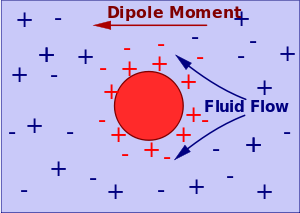Colloid vibration current
- Colloid vibration current
-
Colloid vibration current is an electroacoustic phenomenon that arises when ultrasound propagates through a fluid that contains ions and either solid particles or emulsion droplets .[1]
The pressure gradient in an ultrasonic wave moves particles relative to the fluid. This motion disturbs the double layer that exists at the particle-fluid interface. The picture illustrates the mechanism of this distortion. Practically all particles in fluids carry a surface charge. This surface charge is screened with an equally-charged diffuse layer; this structure is called the double layer. Ions of the diffuse layer are located in the fluid and can move with the fluid. Fluid motion relative to the particle drags these diffuse ions in the direction of one or the other of the particle's poles. The picture shows ions dragged towards the left hand pole. As a result of this drag, there is an excess of negative ions in the vicinity of the left hand pole and an excess of positive surface charge at the right hand pole. As a result of this charge excess, particles gain a dipole moment. These dipole moments generate an electric field that in turn generates measurable electric current.[1] This phenomenon is widely used for measuring zeta potential in concentrated colloids.
See also
References
Wikimedia Foundation.
2010.
Look at other dictionaries:
Streaming Vibration Current/Potential — (SVI) is an electric signal that arises when an acoustic wave propagates through a porous body in which the pores are filled with fluid. :Streaming Vibration Current was experimentally observed in 1948 by Williams [Williams.M. An Electrokinetic… … Wikipedia
Ion Vibration Current/Potential — (IVI)is an electric signal that arises when an acoustic wave propagates through a homogeneous fluid.Historically, the IVI is the first known electroacoustic phenomena. It was predicted by Debye in 1933 [Debye.P. A method for the determination of… … Wikipedia
Electroacoustic phenomena — arises when ultrasound propagates through a fluid containing ions. It moves these ions. This motion generates electric signals because ions have electric charge. This coupling between ultrasound and electric field is called electroacoustic… … Wikipedia
Electrokinetic phenomena — is a family of several different effects that occur in heterogeneous fluids or in porous bodies filled with fluid. The term heterogeneous here means a fluid containing particles. Particles can be solid, liquid or gas bubbles with sizes on the… … Wikipedia
Zeta potential — is an abbreviation for electrokinetic potential in colloidal systems. In the colloidal chemistry literature, it is usually denoted using the Greek letter zeta, hence ζ potential . From a theoretical viewpoint, zeta potential is electric potential … Wikipedia
Nanomaterials — Part of a series of articles on Nanomaterials Fullerenes … Wikipedia
Electric sonic amplitude — is an electroacoustic phenomena that is reverse to colloid vibration current. It occurs in colloids, emulsions and other heterogeneous fluids under influence of oscillating electric field. This field moves particles relative to the liquid, which… … Wikipedia
CVI — may refer to: Chemical vapor infiltration, a chemical vapor deposition type process used for ceramic matrix composites Chronic venous insufficiency, a medical condition affecting veins of the leg Colloid Vibration Current, an electroacoustic… … Wikipedia
Dynamic electrophoretic mobility — is a parameter that determines intensity of electroacoustic phenomena, such as Colloid Vibration Current and Electric Sonic Amplitude in colloids. It is similar to electrophoretic mobility, but at high frequency, on a scale of megahertz. Usual… … Wikipedia
List of cutaneous conditions — This is an incomplete list, which may never be able to satisfy particular standards for completeness. You can help by expanding it with reliably sourced entries. See also: Cutaneous conditions, Category:Cutaneous conditions, and ICD 10… … Wikipedia

